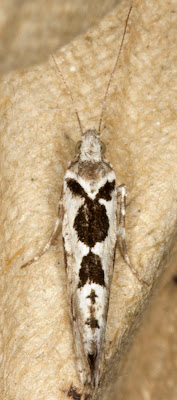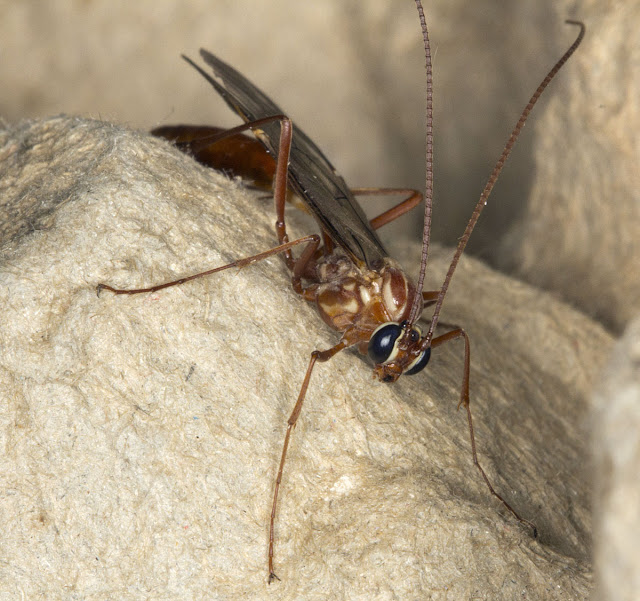 |
| Ypsolopha sequella . Micromoth. Farthing Downs, 4 October 2011. |
The small moth on the right is a micromoth, quite distinctive with that Bugs Bunny outline on its back. Gill Peachey, my informal tutor, does not work with micromoths, but even so, she knew it straight away.
We are starting to see the moths that really belong to the Autumn. I think that the two next down make a good contrasting pair; the Black Rustic does look quite black in normal light, with white pips on its wings, and it's only the strong light of the flash that brings out some detail. It has white underwings.
Further down is the Deep-Brown Dart, on which detail can be seen in normal light if you look carefully.
The Snout is impossible to mistake, even with a faded specimen like this, with its delta-wing shape and pointed facial outline.
The Barred Sallow and a normal Sallow would make a good pair, but the Sallow would not settle down and I couldn't get a photo.
And the last moth on this page is a Red-Green Carpet, quite showy in a dark sort of way. I like the way its eyes match the overall body and wing colour.
Finally, there were lots big ichneumon flies in the trap this time. I don't know the species, but they look quite dramatic.
 |
| Black Rustic, Aporophyla nigra (left) and Autumnal Rustic, Eugnorisma glareosa (right) Noctuids. Moth trap at Farthing Downs with Gill Peachey, 4 October 2011. |
 |
| Deep-Brown Dart, Aporophyla lutulenta. Noctuid. Moth trap at Farthing Downs with Gill Peachey, 4 October 2011. |
 |
| Snout, Hypena proboscidialis. Noctuid. Moth trap at Farthing Downs with Gill Peachey, 4 October 2011. |
 |
| Barred Sallow, Xanthia aurago. Noctuid. Moth trap at Farthing Downs with Gill Peachey, 4 October 2011. |
 |
| Red-Green Carpet, Chloroclysta siterata. Geometer. Moth trap at Farthing Downs with Gill Peachey, 4 October 2011. |
 |
| Unidentified ichneumon fly. Moth trap at Farthing Downs with Gill Peachey, 4 October 2011. |
Maybe the Baton Rouge zoo has a real mongoose (ichneumon). The fly named for it is handsome. But what you have learned, in less than a year it seems, about moths is most impressive. The red-green carpet specimen is quite beautiful. I'm beginning to wonder whether your regional variety of subspecies (if that is what we see) is very widespread. If you were resident in Wales or Portugal, for example, and collected, would you get similar ones? In the suburbs of Paris? In those of Ankara? I mean, collectively, since individually their lifetime is brief, have they traveled as butterflies such as Monarchs do?
ReplyDelete